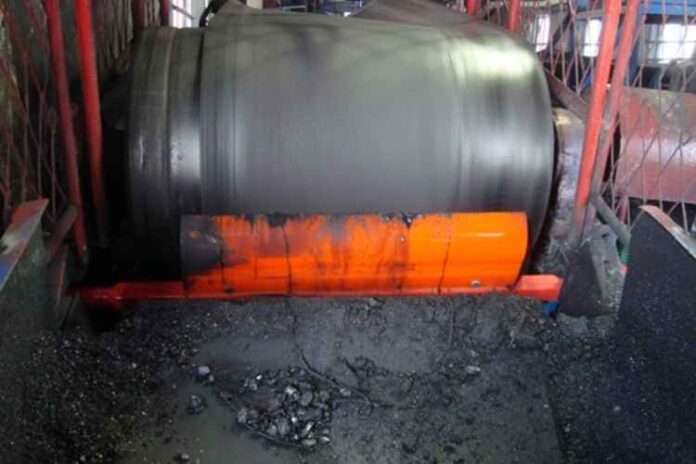Cleaning device
1. Classification of sweepers: scraper type, hydraulic cleaning, strip reversing cleaning (strip reversing cleaning)
No introduction).
(1)Scraper sweeper: it can also be divided into spring sweeper, empty section sweeper and heavy hammer sweeper.
(2) Spring Cleaner:
It is a device that uses the spring to compress the scraper to scrape off the coal on the tape. The working part of the scraper is a strip made of adhesive tape or industrial rubber plate, which is usually as wide as the adhesive tape. It is clamped with flat steel or steel plate and compressed by spring. The lower part of the drum is unloaded at the head to make the scraper close to the working surface of the adhesive tape outside the drum, so as to clean the materials still attached to the working surface of the conveyor belt after unloading. During operation, pay attention to the wear of the tape strip and the tightness of the scraper to the tape.
(3) Empty section Cleaner:
The empty section cleaner is installed on the lower branch belt in front of the drum at the tail of the conveyor belt and the forward direction changing drum of the vertical tensioning device. It is used to clean the materials on the non working surface of the conveyor belt. The working part of the scraper is a tripod made of adhesive tape or industrial rubber plate. The top is usually connected to the frame with an elastic frame, and the tail is connected to the frame with a movable chain frame, so that the scraper is close to the non working surface of the adhesive tape, and the sundries are continuously removed during the movement of the adhesive tape. When a hard object passes through, the elastic sheet will be lifted or the movable dumpling link will be propped up to make it pass through, which is not easy to cause the tape to be scratched.
2. Function of sweeper: a device for scraping off the coal adhered to the tape.
1) Bond to adhesive tape Impact of coal on coal handling machinery:
The small particle coal adhered to the working face of the belt is transmitted to the lower idler and steering roller through the belt. Due to the accumulation of materials, their shape changes and aggravate the wear of the belt. In addition, the coal on the loaded branch conveyor belt falls onto the return belt and is uploaded to the surface of the tensioning drum, and even bonding will occur on the transmission drum. These phenomena affect the deflection of the belt and the uniform distribution of tension, resulting in the deviation and damage of the belt. At the same time, due to the poor sliding of the belt along the supporting wheel, the running resistance increases, and the power consumption of the driving device increases accordingly. The coal bonded on the belt is continuously scattered along the whole length of the conveyor belt, especially near the diversion drum, which seriously pollutes the environment and increases the indoor dust concentration.
Classification of coal plough:
Fixed type (which has been gradually eliminated), variable slot angle type, fixed type and variable slot angle type are divided into one-sided plow unloader and two-sided plow unloader. The single side plow unloader is divided into left side and right side.
3. Structure of coal plough:
It is composed of electric push rod, driving rod support, main plow, auxiliary plow (not available on site), parallel long supporting rod of sliding bed frame, grooved supporting wheel and other mechanisms.
4. Working principle of variable slot angle coal plough:
During unloading, the push rod extends out of the sliding bed frame and moves backward, so that the inner side of the side wheel is lifted, the supporting rod of the grooved movable frame becomes parallel, and the plow head falls to make the belt straight, and the plow fits closely with the plane of the belt and forms a certain angle with the running direction of the belt. When the belt carries coal through the plow, the coal will be separated by the plow and “pushed” down along the two sides of the plow and enter the coal bunker. In the non working state, the push rod is retracted, the sliding bed frame is moved forward and pulled back, so that the inner side of the side stick falls, the supporting wheel of the sliding bed frame becomes a groove shape, the plow is lifted to a certain angle, the materials pass through the next level, and it is not easy to scatter materials outward.
5. Advantages and disadvantages of coal plough:
It has the advantages of safety and reliability, convenient coal blending, simple structure, small maintenance, easy to realize automatic control and so on. The disadvantages are: the force of the electric push rod is not good, the cleanliness of coal ploughing is not high, the maintenance is inconvenient, the belt is greatly worn, and the belt at the coal plough must become horizontal, resulting in the reduction of belt output, and the belt speed cannot exceed 2.5m/s.








